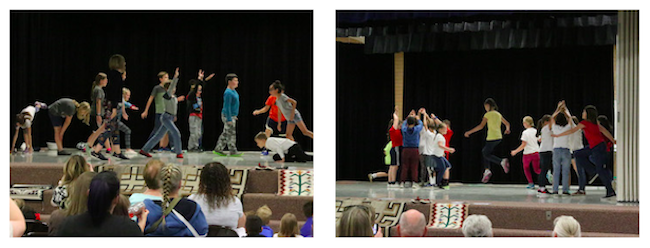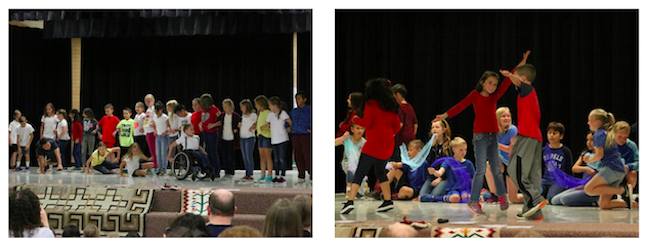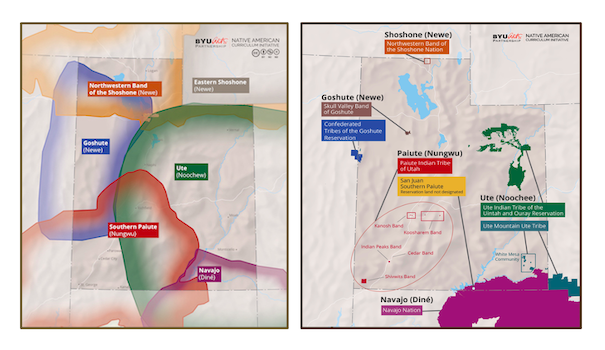SUBJECTS
GRADE
Show Results
Program: Native Americans Within Utah

Lesson Summary
- Learn about the eight sovereign nations derived from the five Native American tribes in Utah through dance, music, and speaking parts
- Analyze the unique, defining attributes of each tribal group
Lesson Plan and Procedure
Lesson Key Facts
- Grade(s): K, 1, 2, 3, 4, 5, 6
- Subject(s): Dance, English Language Arts, Social Studies, Native American
- Duration of lesson: Varies
- Author(s): Rachel Marie Kimball and Brenda Beyal
Elementary Program Outline
Created by Rachel Marie Kimball and Brenda Beyal in collaboration with the 4th Grade Team (2017-18) at Meadow Brook Elementary in the Nebo School District (Jessika Anderson, Camie Simpson, and KC Fotheringham) and with artists, educators, and cultural bearers of the eight sovereign nations within Utah.
Acknowledgement: We are grateful to all Native American cultural bearers, educators, and artists who have shared their knowledge and gifts with us for the creation of this program. We are grateful for what has been gifted to us, and we desire all educators and students to be respectful with the materials and information in this program.
First Program: Spring 2018
Latest Revisions: Spring 2023
Purpose of Program: To help teachers, students, and audience members become familiar with and appreciate the 5 tribal groups and 8 sovereign nations in Utah -- each with its own unique identity-- and that while Native Americans treasure rich histories of traditions and experiences, they also maintain powerful roles in today's world as bearers of cultural traditions and by fulfilling positions in the modern day society. This program is designed to form and strengthen relationships between teachers, students, and the Native community in their area.
Sovereign Nations Addressed in Program: Navajo Nation, Paiute Indian Tribe of Utah, San Juan Southern Paiute Tribe, Ute Indian Tribe of the Uintah and Ouray Reservation, Ute Mountain Ute Tribe, Confederated Tribes of the Goshute Reservation, Skull Valley Band of the Goshute, and Northwestern Band of the Shoshone Nation
Length of Program: Approximately 30 - 45 minutes
Contents of Program:
- Program Script / Speaking Parts about the 5 tribal groups / 8 sovereign nations
- Class Dances based on tribal groups and sovereign nations
- Guest Performances from local Native American artists
- Optional Visuals: Use parts of this lesson plan to project visuals during the program
Guidelines for Creative Dances
- Dance Assignments: While there are many ways to approach this program, be sure that each tribal group is represented through the script and dances. Here are some examples of how to approach dance assignments:

- Music: Use approved music mentioned in this program.
- Creative Movement: Use a variety of energy qualities, levels, pathways, body parts, and timing to create educational and engaging dances, and to avoid pantomime. Reference for Elements of Dance

- Symbolic Movement: Use creative dance movement to represent characteristics and details of tribal groups:
- Group shapes
- symbolic of traditional homes
- Creative movements to represent a significant art / trade / skill
- Creative movements based on the Great Seal(s)
- Creative movements related to the landscapes and animals of the ancestral lands

- Costuming: Costuming can be done in connection with culturally significant colors and elements as they pertain to each individual tribe. We urge those doing the program to never dress students in clothing that copies traditional Native American clothing as this is cultural appropriation and often leads to the homogenization and stereotyping of cultures.
- Speaking Parts: Use speaking parts before each dance to explain to the audience which sovereign nations they are representing and the symbolism of the movement they are about to see.
Guest Artists
Connect with the Native community in your area to invite Native Americans to share traditional dances in your program. These dances are to be performed only by those of Native American descent, or those given a direct invitation to learn the dance by those of the tribal group or sovereign nation. Ideally, each creative dance performed by students will be followed by a brief sharing of traditional Native American dance. These dances can be done with the same music the students just previously danced to, or can be done with music provided by the guest artist. Invite the guest artists to help you find the most appropriate place in the program for them to share their dances. All guest artists can make a final, shared appearance together at the end of the 8 Sovereign Nations dance, performing a snippet of their traditional dances simultaneously one last time to the same song. If possible, guest artists would perform at the end of the creative dance of the tribal group they are connected to, however this is not mandatory as the script will explicitly state the sovereign nation the guest artist comes from.
Specific Considerations
- The Round Dance is a dance shared by many tribal groups, and although all can participate, it ought to be led by one of Native American descent.
- Plains Powwow Dances include fancy dance, grass dance, jingle dance, hoop dance, and others. These dances, while originating from the plains Indian tribes, are now learned and performed by many other tribal groups.
- Tribe Specific Dances are at times meant for only sacred ceremonies. Others, however, can be shared in other settings by approval of those of the tribal group or sovereign nation. Examples: Sash Belt Dance (Navajo), Basket Dance (Navajo), Round Dance (shared), etc.
Note: Consider inviting Native American guest artists of other artforms to take part of the program as well, such as drummers, singers, flutists, weavers, painters, storytellers, and so on.
Tips for Preparing to Perform
- Help students become familiar with the performance area (stage, gym floor, etc.) by giving them at least two opportunities to rehearse in the space.
- Place tape markers on the floor where needed to help students with spacing on the stage during their dances.
- Record the students going through their dance at least once for them to watch. As they watch the recording, invite them to watch for specific things that they do well, but also for specific things that they can improve upon. Discuss it together.
- When rehearsing, make it a fun challenge for students to be able to get through the dance without the teacher’s help!
- If possible, see if another class will allow your students to practice performing for them. Invite the class watching to provide feedback.
Working with the Native Community in Your Area
While this program is designed to help create and strengthen the relationships between teachers, students, and the local Native community, it is in the hands of the teachers and other district personnel to be proactive with the recommendations. Teachers and administrators should start by making connections with the Title VI Representative in the district.
Additional Native American Artist Reference:
Ancestral Lands Map and Sovereign Nations Map
Refer to these maps to know which ancestral lands you live on, and which sovereign nations are near you today:

Pronunciation Guide
| Diné (<Dineh>) Nungwu (<noong-wu>) Nungwutsi (<noong-woot-see>) Nuche (<nooch>) Noochee (<nooch-ee>), or Noochew (<nooch-u>) Newe (<new-uh>) | Gosiutta (<go-see-yoo-ta>) Newe (<new-wa>) So-so-goi (<sō-sōn-goy>) Algonquin (<al-gong-kwin>) Khan (<kahn>) Kahni (<ghan-ee>) |
Learning Objectives
- Understand the difference between Native American tribal groups and sovereign nations
- Appreciate unique attributes of tribal groups and sovereign nations in the Utah area
- Demonstrate a variety of dance qualities individually and in small groups
Utah State Board of Education Standards
This lesson can be used to meet standards in many grades and subject areas. We will highlight one grade’s standards to give an example of application.
Grade 2 Dance
- Standard 2.D.CR.2: Explore movement inspired by a variety of stimuli.
- Standard 2.D.P.4: Demonstrate clear pathways and intent when performing locomotor and non-locomotor movements.
Grade 2 Social Studies
- Standard 2.1.2: Use primary sources to identify how their community has changed or remained the same over time
- Standard 2.2.7: On a map of the world, locate where their families or other families in the community historically came from. With support, curate and share information about the traditional food, cultural customs, recreation, religion, and music of that country and/or region.
Grade 2 Language Arts
- Standard 2.R.12: Demonstrate understanding of topics by applying information gained from illustrations or text features. (RL & RI)
Equipment and Materials Needed
- Program Script / Speaking Parts about the 5 tribal groups / 8 sovereign nations
- 5 Tribal Groups, 8 Sovereign Nations slide presentation
- Recommended Native Music to dance with in the program:
- Additional Music to explore creative movement with:
Additional Resources
This lesson was created thanks to a grant from the National Endowment for the Arts and the Utah Division of Arts & Museums.
- Utah's Eight Tribal Nations
- Navajo Nation Website Link
- Northwestern Band of the Shoshone Website Link
- Ute Indian Tribe Website Link
- Ute Mountain Ute White Mesa Website Link
- Confederated Tribes of the Goshute Reservation Website Link
- Skull Valley Band of the Goshute Website Unavailable (Utah Gov Website)
- Paiute Indian Tribe of Utah Website Link
- San Juan Southern Paiute Tribe Website Link
- https://native-land.ca/
- https://www.pbs.org/video/kued-local-productions-we-shall-remain-ute/
Image References
Image 1: https://www.flickr.com/photos/number7cloud/35898272995/in/photostream/
Images 2-6: James Huston
Images 7-8: BYU ARTS Partnership

www.education.byu.edu/arts/lessons
 Download
Download